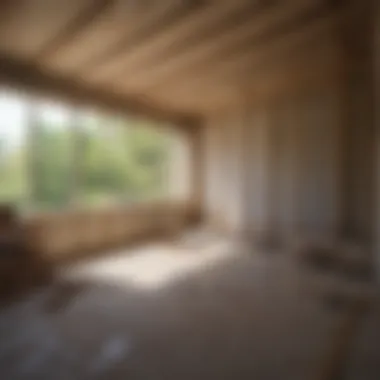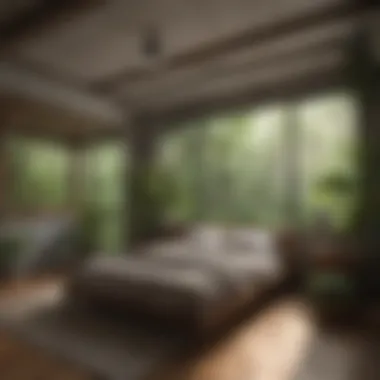Exploring the Average Cost Room Addition per Square Foot Insights


Setting Financial Goals
Despite the wide-ranging financial attractiveness of room additions per square foot, it's crucial to define clear financial goals before delving into the project. By establishing realistic objectives, individuals can navigate the complexities of budgeting, expense management, and potential debt accumulation with more certainty and precision. Throughout this section, we will explore the importance of setting goals, offer insights into establishing feasible financial objectives, and underline the significance of tracking progress to make necessary adjustments along the way.
Budgeting and Expense Management
One of the primary pillars of financial stability in any home improvement endeavor is prudent budgeting and expense monitoring. Creating a personal budget that encompasses all potential costs associated with a room addition per square foot is fundamental in mitigating unforeseen financial burdens. Additionally, we will provide practical tips on trimming expenses and saving money without compromising the quality of the project. Moreover, we will introduce readers to innovative tools and apps designed to streamline expense tracking and enhance financial organization.
Saving and Investing
A strategic approach to saving and investing plays a pivotal role in the success of a room addition per square foot project. Building an emergency fund can safeguard against financial setbacks, offering a safety net in unpredictable situations. Exploring various investment options such as stocks, bonds, and ETFs can present avenues for capital growth and wealth accumulation. Moreover, diversifying one's investment portfolio is essential for long-term financial security, and we will delve into effective strategies for achieving this vital objective.
Debt Management
Understanding the nuances of debt management is crucial for individuals undertaking a room addition per square foot project. By comprehending the different types of debt and formulating a structured repayment plan, individuals can navigate through potential financial liabilities with confidence. Furthermore, we will explore debt consolidation and refinancing options that could potentially optimize financial efficiency and reduce interest burdens, offering readers valuable insights into managing debt effectively.
Retirement Planning
While embarking on a room addition per square foot project, it's essential not to overlook the importance of meticulous retirement planning. Early planning for retirement can secure a stable financial future, ensuring a comfortable and stress-free post-career life. By familiarizing individuals with various retirement accounts such as 401(k) and IRAs, we aim to equip readers with the knowledge needed to make informed decisions. Additionally, maximizing retirement savings through employer matching contributions will be emphasized as a key strategy for boosting long-term financial well-being.
Introduction
Understanding Room Additions
Definition of Room Additions
Room additions refer to the expansion of living spaces within a home, whether it be adding a new room, extending an existing area, or repurposing underutilized spaces. This segment explores the precise definition of room additions and its significance in the context of home improvement. Understanding the key characteristics of room additions sheds light on why it remains a popular choice among homeowners seeking to maximize their living space efficiently. Delving into the unique features of room additions reveals their advantages and disadvantages, providing readers with a nuanced perspective on integrating such additions into their homes.
Benefits of Room Additions
The benefits of room additions extend beyond merely increasing square footage. They include enhanced functionality, improved aesthetics, and potentially higher property value. This subsection delves deeper into the positive impact of room additions, underscoring why they are favored by homeowners embarking on renovation projects. By highlighting the advantages and potential drawbacks of room additions, readers gain a holistic view of the benefits and considerations associated with this particular home improvement strategy.
Importance of Cost Evaluation
Determining Budget Allocation
One of the critical aspects of room additions is determining how to allocate a budget effectively. This section focuses on the importance of establishing a clear budget allocation plan to ensure the project stays within financial limitations. By emphasizing the key characteristics of budget allocation, readers can appreciate why meticulous financial planning is crucial in the context of room additions. Exploring the unique features of budget allocation highlights its advantages and potential challenges, equipping readers with the knowledge necessary for prudent financial decision-making.
Factors Affecting Overall Cost
Numerous factors can significantly impact the overall cost of room additions, ranging from material choices to labor expenses. This subsection delves into the key factors that influence project costs, offering readers a comprehensive understanding of the financial variables at play. By highlighting the characteristics of these cost-influencing factors, readers can grasp why certain elements carry more weight in budget considerations. Examining the unique features of cost influencers illuminates both their benefits and potential pitfalls, empowering readers to navigate the complexities of project costing effectively.


Scope of the Article
Providing Cost Estimates
Offering cost estimates is crucial in helping homeowners plan their room addition projects efficiently. This segment delves into the significance of providing accurate cost projections, enabling readers to gauge the financial scope of their renovation plans. By highlighting the key characteristics of cost estimation, readers can discern why reliable estimates are fundamental in avoiding budget overruns. Exploring the distinct features of cost projections sheds light on their advantages and disadvantages, guiding readers in formulating realistic financial expectations for their home improvement projects.
Highlighting Cost Variances
Cost variations inherently exist in construction projects, and room additions are no exception. This section explores the nuances of cost variances, drawing attention to the potential fluctuations in project expenses. By underscoring the key characteristics of cost deviations, readers can understand why flexibility and contingency planning are crucial in managing financial uncertainties. Examining the unique aspects of cost variances reveals both their benefits and challenges, equipping readers with the foresight to navigate cost fluctuations effectively.
Factors Influencing Costs
Factors influencing costs play a pivotal role in determining the overall expenditure associated with room additions. It is imperative to delve into various elements that contribute to the financial aspects of this endeavor. By understanding the intricacies of materials, labor costs, design complexity, and regulatory requirements, individuals can make informed decisions to manage expenses effectively.
Materials
High-End Materials
High-end materials offer premium quality and aesthetics, elevating the overall appearance and functionality of room additions. These materials are known for their durability, luxurious appeal, and superior performance. While high-end materials come at a higher price point, they often justify the cost through longevity and enhanced appeal. Homeowners seeking a sophisticated and upscale finish for their room additions may opt for high-end materials to achieve a premium look and feel.
Economical Alternatives
On the contrary, economical alternatives provide cost-effective solutions without compromising on quality. These materials offer a budget-friendly option for individuals looking to control expenditure without compromising on durability and visual appeal. While economical alternatives may not boast the same luxury as high-end materials, they serve their purpose effectively by offering suitable options for those with financial constraints.
Labor Costs
Skilled Labor Rates
Skilled labor rates reflect the expertise and proficiency of professionals involved in room additions. Hiring skilled labor ensures high-quality workmanship, attention to detail, and timely completion of projects. While skilled labor rates may be higher than average, the assurance of superior craftsmanship and smooth execution justifies the investment. Homeowners prioritize skilled labor for complex projects that require precision and finesse.
DIY Options
Alternatively, do-it-yourself (DIY) options present a cost-saving opportunity for individuals with construction skills and time to invest. DIY projects allow homeowners to reduce labor costs significantly by undertaking certain tasks independently. While DIY options can save money, they require careful planning, adequate skills, and adherence to safety guidelines. Homeowners considering DIY should assess their capabilities realistically before embarking on such projects.
Design Complexity
Simple vs. Elaborate Designs
The complexity of design influences overall costs, with simple designs typically costing less than elaborate ones. Simple designs feature clean lines, minimalistic elements, and straightforward construction, making them more budget-friendly. On the other hand, elaborate designs encompass intricate details, custom features, and architectural nuances that elevate the project's grandeur but also increase expenses. Homeowners must weigh the aesthetic appeal against the budget constraints when deciding between simple and elaborate designs.
Architectural Considerations
Architectural considerations involve structural elements, building codes, and design specifications that impact the overall project cost. Incorporating architectural features like vaulted ceilings, skylights, or custom millwork can enhance the visual impact but also add to the expenses. Homeowners seeking distinctive and personalized room additions may opt for architectural enhancements that reflect their unique style preferences.


Permitting and Regulations
Legal Requirements
Adhering to legal requirements is essential to ensure compliance with building codes, safety standards, and zoning regulations. Violating legal requirements can result in fines, construction delays, or even project abandonment. By understanding and adhering to legal prerequisites, homeowners mitigate risks and ensure a smooth progression of their room addition projects.
Permit Costs
Obtaining permits incurs costs associated with application fees, inspections, and compliance documentation. These permit costs are necessary to obtain official approval for construction activities and ensure that the project meets regulatory standards. While permit costs contribute to the overall expenses, they are non-negotiable expenses that homeowners must account for in their budget planning.
Estimating Costs
Estimating costs is a fundamental aspect of this detailed article on the average cost per square foot for room additions. Understanding the financial implications of a room addition project is crucial for individuals planning such ventures. By delving into the various cost elements associated with room additions, readers can gain a comprehensive view of what to expect in terms of expenditure and budget allocation. Discussing the estimation process provides valuable insights into how to plan effectively and make informed decisions regarding the financial aspects of home improvement projects.
Average Cost Range
Low-End Estimates
In the realm of room additions, low-end estimates play a significant role in determining the budgetary constraints of a project. These estimates typically represent the baseline costs, providing a starting point for financial planning. The key characteristic of low-end estimates lies in their affordability, making them a popular choice for budget-conscious individuals undertaking room addition projects. While low-end estimates offer cost-effective solutions, they may come with limitations in terms of material quality or design options. Despite these potential drawbacks, low-end estimates serve a crucial purpose in helping homeowners establish a realistic financial framework for their room addition endeavors.
High-End Estimates
Contrary to low-end estimates, high-end estimates signify a more indulgent approach to room additions, incorporating premium materials and sophisticated design elements. The defining feature of high-end estimates is their emphasis on luxury and customization, catering to homeowners seeking upscale and lavish room expansion solutions. Although high-end estimates elevate the overall aesthetic and quality of a room addition, they come at a higher price point. The advantage of high-end estimates lies in the superior craftsmanship and upscale finishes they offer, ensuring a high-end result for those willing to invest in top-tier renovation options.
Budget Planning
Setting Realistic Budgets
Setting realistic budgets forms the cornerstone of effective financial management in room addition projects. By accurately assessing the costs involved and setting realistic financial boundaries, homeowners can avoid budgetary strain and unexpected expenses. The key characteristic of setting realistic budgets is its proactive approach to financial planning, enabling individuals to align their renovation goals with their budgetary limitations. Choosing this method is a prudent decision for those looking to maintain financial stability while indulging in home improvement endeavors.
Factors to Include
Incorporating various factors into the budget planning phase is essential for comprehensive cost estimation in room addition projects. Factors to include revolve around material costs, labor expenses, permit fees, and unforeseen contingencies. Highlighting these components within the budget enables individuals to account for all potential outlays, minimizing the risk of overspending or financial setbacks. The unique feature of factoring in multiple elements is the holistic approach it offers, ensuring that no cost remains unaccounted for during the budgeting process.
Hidden Costs
Overlooked Expenses
Hidden costs, often disguised as overlooked expenses, have the potential to disrupt the financial dynamics of a room addition project. Identifying and addressing these hidden expenditures is vital for maintaining budgetary control and preventing financial surprises. The key characteristic of overlooked expenses is their unexpected nature, catching homeowners off guard if not proactively accounted for during the planning phase. Recognizing and mitigating these costs early on is beneficial for ensuring a smooth and financially sustainable room addition process.
Contingency Fund Importance


Emphasizing the importance of a contingency fund in room additions underscores the value of preparedness and flexibility in financial planning. Allocating funds for unforeseen circumstances and additional costs safeguards homeowners against budget overruns and unexpected financial burdens. The unique feature of a contingency fund lies in its ability to provide a financial safety net, offering peace of mind and reassurance throughout the room addition project. Prioritizing this aspect ensures financial stability and enables individuals to tackle challenges without compromising the overall project quality.
Cost-Saving Strategies
Cost-saving strategies play a pivotal role in any home improvement project, including room additions. As the financial aspect is crucial, understanding effective cost-saving measures becomes imperative. By implementing appropriate strategies, homeowners can optimize their budget allocation and achieve a successful outcome. This section delves into various elements surrounding cost-saving strategies, shedding light on their benefits and considerations.
Negotiation Tips
Dealing with Contractors
Delving into the realm of dealing with contractors is a fundamental aspect of cost-saving strategies for room additions. Contractors significantly impact the overall project cost and outcome. Understanding how to negotiate with contractors can lead to cost efficiencies and ensure quality workmanship. The key characteristic of this negotiation tactic lies in establishing clear communication, setting expectations, and negotiating favorable terms for both parties involved. By engaging in detailed discussions with contractors, homeowners can secure competitive pricing, quality materials, and timely project completion.
Material Suppliers
Material suppliers form another essential component of negotiation tips for cost-saving strategies. Collaborating with reliable material suppliers can result in obtaining discounts, sourcing high-quality materials, and streamlining the procurement process. The key characteristic of navigating material suppliers is to build strong relationships, leverage bulk purchasing opportunities, and explore cost-effective alternatives without compromising on quality. Engaging with reputable suppliers ensures a smooth supply chain, timely deliveries, and cost efficiencies, contributing significantly to the overall success of room addition projects.
DIY Considerations
Suitable Tasks for DIY
Embracing do-it-yourself (DIY) tasks within room additions provides homeowners with opportunities to reduce labor costs and get hands-on with the project. Identifying suitable tasks for DIY involves considering one's skill level, available time, and project requirements. The key characteristic of DIY tasks is the sense of accomplishment and cost savings that come from personal involvement in the renovation process. While DIY tasks offer cost advantages, it is essential to assess the complexity of each task and prioritize safety to avoid potential risks or errors.
Safety Precautions
Prioritizing safety precautions is a critical aspect of DIY considerations for room additions. Ensuring a safe working environment and adhering to best practices can prevent accidents, injuries, and property damage. The key characteristic of safety precautions lies in following proper safety protocols, utilizing safety equipment, and seeking assistance for hazardous tasks. Integrating safety measures into DIY endeavors promotes a secure working environment, safeguards against unforeseen incidents, and upholds project quality and integrity.
Optimizing Design Choices
Cost-Effective Alternatives
Exploring cost-effective alternatives in design choices offers homeowners opportunities to maximize value while adhering to budget requirements. Identifying cost-effective materials, design solutions, and construction methods is essential for achieving desired outcomes within financial constraints. The key characteristic of cost-effective alternatives is their ability to deliver aesthetic appeal, functionality, and durability at affordable prices. By selecting smart design options and optimizing material usage, homeowners can enhance the overall cost efficiency of their room addition projects.
Long-Term Savings
Delving into long-term savings aspects in design choices underscores the significance of sustainable and energy-efficient solutions. Investing in long-term savings measures such as energy-efficient appliances, insulation, and renewable materials can lead to reduced utility costs and environmentally friendly spaces. The key characteristic of long-term savings initiatives is their potential to generate ongoing financial benefits and environmental impact. By prioritizing long-term savings considerations in design, homeowners can create sustainable living spaces that align with their financial and environmental goals.
Conclusion
Summarizing Key Points
-### Importance of Detailed Planning Detailed planning stands as the cornerstone of any successful room addition venture. By meticulously laying out the project scope, budget, and timeline, individuals can preempt challenges and streamline the construction process. The key characteristic of detailed planning lies in its ability to minimize surprises and ensure projects stay on track. Its advantage within this article is evident through the emphasis on avoiding cost overruns and schedule delays, providing a structured approach to achieving desired outcomes.
-### Balancing Quality and Costs Balancing quality with costs is an art that homeowners must master when undertaking room additions. Maintaining a high level of craftsmanship while adhering to budget constraints requires conscious decision-making. The key characteristic here is finding the sweet spot where quality meets affordability, maximizing the investment's value. This balance ensures that the finished addition not only looks impressive but also stands the test of time, aligning with the overall goal of creating enduring value for the property.
Final Thoughts
-### Empowering Homeowners Empowering homeowners through knowledge and confidence is vital in navigating the complexities of room additions. By arming individuals with information on costs, design options, and cost-saving strategies, this article empowers them to make informed decisions. The key characteristic of this empowerment lies in fostering a sense of control and involvement in the renovation process, instilling a sense of ownership over the project. The advantage of this empowerment is in enabling homeowners to communicate effectively with contractors, set realistic expectations, and ultimately achieve the desired outcome for their living space.
-### Encouraging Informed Decisions Encouraging informed decisions is the essence of this article, urging readers to critically assess options and make choices that align with their vision and budget. By shedding light on the importance of negotiation, DIY considerations, and design optimization, readers are encouraged to think strategically about their room addition projects. The unique feature of this encouragement lies in promoting a proactive rather than reactive approach to home improvement, empowering individuals to take charge of their investment. The advantage of these informed decisions is in ensuring that homeowners achieve satisfaction with the final result, knowing that every choice was made deliberately and with full awareness of its implications.



